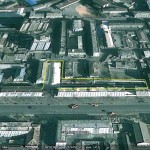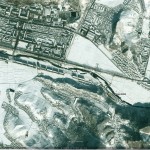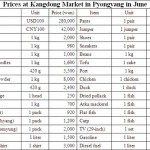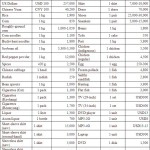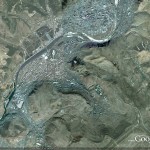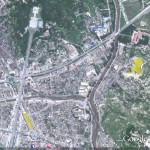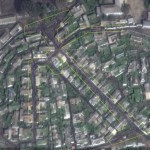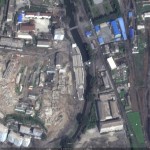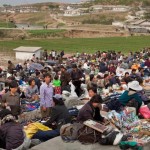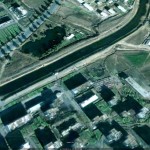According to the AFP:
North Korea has drastically cut public food handouts as it heads towards a new hunger crisis with people again eating grass to survive, one of the most experienced aid workers in the isolated nation said.
Food rations have been cut to as low as 150 grammes (5.3 ounces) a day per person in some parts of the country as foreign donations collapse and higher international prices make imports more expensive, said Katharina Zellweger, head of a Swiss government aid office in Pyongyang.
…
Food supplies to the estimated population of 23 million people have been controlled through a public distribution system for decades.
“It works sometimes and sometimes it doesn’t work,” the head of the Swiss Agency for Development and Cooperation office in Pyongyang told a group of UN correspondents.
“The lowest I heard was 150 grammes per person per day, and I even heard that in Pyongyang the rations are cut to 200 grammes per person per day.”
Diplomats say the rations have been halved over the past 18 months. One hundred grammes of rice produces about 250-350 calories a day, experts said.
Zellweger said she had seen “a lot more malnourished children” on recent travels around the country.
“You see more people out in the fields and on the hillsides digging roots, cutting grass or herbs. So there are signs that there is going to be a crisis.”
At the same time the Daily NK reports:
Anecdotal evidence suggests that the market price of potatoes in North Korea has risen substantially in recent weeks, with farms unable to supply the jangmadang because drought and a lack of fertilizer have had a detrimental effect on this year’s spring harvest.
One farmer from North Hamkyung Province revealed his concerns in a phone interview with The Daily NK on the 26th, saying, “This year, potatoes have not done well because of the drought and fertilizer situation, so I have nothing to sell in the market. I am worried about what we are going to do until the corn comes in August.”
Spring potatoes harvested in early June are a decisive food for North Korean farmers. They receive their share of the autumn harvest in December, but once the People’s Army has received its share and various debts have been repaid, they only get enough food for three or four months. After this, potatoes are an important staple to see them through until corn can be harvested in July and August.
However, after deducting cost incurred in bringing together seeds, fertilizer, agricultural chemicals, farm machinery, irrigation equipment and fuel, a farmer receives distribution depending upon his individual work points, decided according to his/her working hours. Since deductions are high, the share for farmers is low, sources say.
The price of potatoes has even risen sharply in Yangkang Province, the center of North Korean potato production. According to Yangkang Province sources, potatoes there are currently selling for between 900 and 1,000 won/kg, double the price of last year.
Fortunately, the high price of potatoes has not had any influence on rice prices. According to one source, “Rice is being sold steadily, and the price is stable not rising.” In the market in Hyesan, rice is now on sale for between 1,900 and 2,100 won/kg, not much more than it was before the spring shortages began.
Finally, new video footage smuggled out of the DPRK suggested that food supplies are particularly tight in distant towns, even for soldiers:
“Everybody is weak,” says one young North Korean soldier. “Within my troop of 100 comrades, half of them are malnourished,” he said.
The DPRK has requested food aid this year, but donors have been reluctant to meet their demands for a number of reasons. See related stories here.
According to the Chirstian Science Monitor:
A central question is whether North Korea needs emergency shipments as called for by the World Food Program. Yes, Ms. Park acknowledges, “The problem this year is changed by flood and winter cold,” but the widespread view here is that North Korea basically has enough food.
It’s believed that North Korea wants to stockpile food for celebrations planned next year to mark the 100-year anniversary of the birth of the late Kim Il-sung, the long-reigning “Great Leader” who died in 1994 after passing on power to his son, current leader Kim Jong-il.
“There’s a need, but we don’t know how great it is,” says a knowledgeable western observer. “My hunch is it’s less about a shortage of food and more about unequal distribution. You can buy rice in the markets if you have the means.”
…
South Korean leaders appeared relieved when Secretary of State Hillary Clinton recently made it clear that the US did not believe North Korea had addressed “serious concerns about monitoring” food distribution. The US still wants to know what happened to 20,000 tons of rice that’s strongly believed to have gone to North Korean soldiers when a US food aid program was suspended two years ago.
And on June 30, Yonhap reported:
North Korea imported more than 50,000 tons of grains from its key ally China in May, an expert said Thursday, amid chronic food shortages in the North.
The North purchased 50,328 tons of corn, flour and rice in May, up 31.5 percent compared to the same period last year, said Kwon Tae-jin, a North Korea expert at the Korea Rural Economic Institute.
The North also imported 114,300 tons of fertilizer from China in the first five months, a rise of 39 percent compared to the same period last year, Kwon said, citing figures from Seoul’s Korea International Trade Association.
China is the North’s last remaining ally, key economic benefactor and diplomatic supporter.
